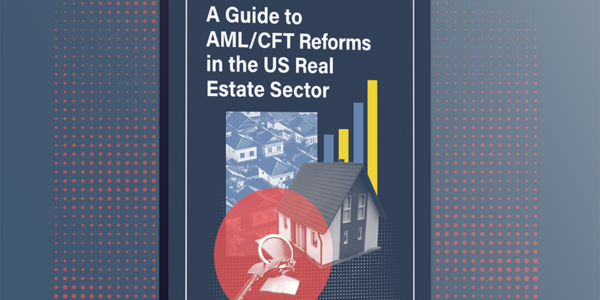
A Guide to AML/CFT Reforms in the US Real Estate Sector
Learn how real estate businesses can respond to US authorities' new measures for improved corporate transparency and financial crime risk management.
Download Your CopyReal estate is a highly lucrative target for fraudsters, with numerous transactions occurring worldwide on a daily basis. In 2022, US victims of real estate fraud suffered losses of almost $400 million, according to data from the FBI’s Internet Crime Complaint Center. In the UK, real estate fraud caused losses of £110 million in the first six months of 2021.
One of the many scam types that fall under the category of real estate fraud is mortgage fraud. Incidences of this increased by 32 percent in England and Wales between April 2022 and March 2023.
Mortgage fraud is a type of white-collar crime that involves dishonesty or deception during the mortgage lending process. This kind of scam happens when borrowers, mortgage brokers, appraisers, or even lenders intentionally provide false or misleading information to obtain a mortgage loan or to influence the terms of a loan.
Depending on the criminal’s intent, mortgage fraud can fall into two general categories: fraud-for-profit and fraud-for-housing.
In fraud-for-profit schemes, individuals or groups intentionally manipulate the mortgage process to make a profit. They may engage in activities such as inflating property values, creating fake documentation, or conducting straw buyer schemes. One common example is property flipping fraud, where a property is purchased, artificially inflated in value, and then quickly resold to unsuspecting buyers at the inflated price.
Fraud-for-housing schemes differ as they involve individuals who want to obtain a mortgage to purchase a home for personal use but provide false information on their application to qualify for a loan. This can include misrepresenting their income, employment status, or financial assets to secure a mortgage that they would not otherwise be eligible for.
Regardless of the scheme type, the majority of mortgage fraud cases between 2017 and 2022 were first-party, meaning that the person who applied for the mortgage was also responsible for the fraud. In fact, according to UK mortgage fraud statistics gathered by Uswitch, first-party fraud accounted for 93 percent of mortgage fraud cases in Q2 2022. The remaining 7 percent of cases were attributed to third-party fraud, where an individual creates or uses other people’s accounts without their consent. This is commonly associated with synthetic identity fraud.
Within the two overarching categories of fraud-for-profit and fraud-for-housing, mortgage fraud can take several forms, including:

Learn how real estate businesses can respond to US authorities' new measures for improved corporate transparency and financial crime risk management.
Download Your CopyTo mitigate the risk of mortgage fraud, compliance teams should be aware of the following red flag indicators and conduct thorough due diligence when any suspicious activity is identified:
When submitting a suspicious activity report (SAR) related to a potential mortgage fraud scheme, the Financial Crimes Enforcement Network (FinCEN) requires US firms to provide a detailed description of the red flags that have been detected. Additionally, firms should include the “NMLS Unique Identifier” assigned by the Conference of State Bank Supervisors’ (CSBS) National Mortgage Licensing System and Registry (NMLS) in the narrative section of the SAR.
Penalties for mortgage fraud in the United States can vary based on federal and state laws, the severity of the fraud, and the specific circumstances surrounding the case. Under federal law, mortgage fraud is a Class C felony that can result in up to 20 years in prison, three years of supervised release, and $5 million in fines. Some common penalties associated with mortgage fraud include:
Similarly, if someone is found guilty of mortgage fraud in the UK different punishments could be imposed depending on the conviction type. Under the Fraud Act 2006, a defendant may be sentenced to imprisonment for a maximum of 10 years and/or a fine. Additionally, they may be subject to a confiscation order under the Proceeds of Crime Act 2002.
FIs play a crucial role in detecting and mitigating the risk of mortgage fraud, which can result in significant financial losses and damage to their reputation. Some important measures to include in a fraud risk management framework include:
While steps can be taken to prevent mortgage fraud through verifying customer identities, educating employees, and updating policies, companies that take an AI-driven approach are much more likely to stay one step ahead of fraudsters.
To effectively mitigate the risk of mortgage fraud, firms should:
RealPage manages 100 million transactions every year for 19 million properties worldwide. As a payments provider, it must monitor transactions to prevent real estate scams like mortgage fraud. RealPage needed a custom solution to identify evolving fraud methods in real-time and enable analysts to manage alerts more efficiently. Learn more about RealPage’s story in the full article.
Request a demo to see how our fraud detection capabilities can help you see the unseen.
Get Started NowOriginally published 24 October 2023, updated 03 September 2024
Disclaimer: This is for general information only. The information presented does not constitute legal advice. ComplyAdvantage accepts no responsibility for any information contained herein and disclaims and excludes any liability in respect of the contents or for action taken based on this information.
Copyright © 2025 IVXS UK Limited (trading as ComplyAdvantage).